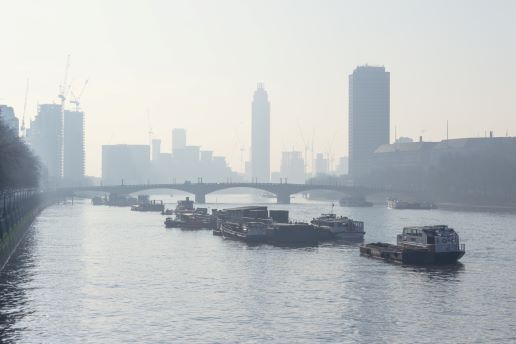
Why is Ozone your best friend and your worst enemy?
25 April 2023
Ozone is our best friend and our worst enemy by becoming a primary atmospheric pollutant. What does this mean for our health and how do we control indoor ozone levels?
The discovery of our best friend, Ozone
In 1840, German scientists announced the discovery of ozone. Until the 20th century, ozone has been regarded as the one beneficial gas, which can be used for disinfection, paint production and processing, and food preservation.
Its most famous function is to absorb ultraviolet radiation and protect life on earth.
When good friends go bad
When Ozone forms at ground level (or the troposphere) through chemical reactions between oxides of nitrogen (NOx) and volatile organic compounds (VOC), it becomes incredibly dangerous to our health. In simple terms, this chemical reaction happens when pollutants emitted by cars, power plants, industrial boilers, refineries, chemical plants, and other sources react chemically in the presence of sunlight. Volatile organic compounds also exist in a wide range of organic solvents such as paints, printing inks, adhesives, sealants, and even plants.
Why is it bad for our health?
Ozone can cause the muscles in the airways to constrict, trapping air in the alveoli. This leads to wheezing and shortness of breath. Even relatively low levels of ozone can cause health effects.
Depending on the level of exposure, ozone can:
- Cause coughing and a sore or scratchy throat.
- Make it more difficult to breathe deeply and vigorously and cause pain when taking a deep breath.
- Inflame and damage the airways.
- Make the lungs more susceptible to infection.
- Aggravate lung diseases such as asthma, emphysema, and chronic bronchitis.
- Increase the frequency of asthma attacks.
- Increase fatal diseases such as lung cancer, ischemic heart disease, and stroke, and may be associated with COPD
- There is an association with diabetes and degenerative neurological diseases.
Long-term exposure to ozone is linked to aggravation of asthma and is likely to be one of many causes of asthma development. Studies in locations with elevated concentrations also report associations of ozone with deaths from respiratory causes.
Research by the US Environmental Protection Agency has proven that instantaneous or prolonged exposure to high concentrations of ozone may not only cause respiratory diseases but also cardiovascular diseases such as stroke and arrhythmia, as well as neurological diseases such as autism and Alzheimer’s disease in children.
The first recorded ‘smog’
A high level of ozone is commonly called ‘smog’.
The first recorded photochemical ‘smog’ incident that broke out in Los Angeles in the 1950’s and 60’s was the world’s first large-scale ozone pollution incident, breaking the ozone “good man” filter.
According to some studies, the ozone concentration in Los Angeles reached thousands of micrograms per cubic meter at that time, causing many people to have headaches, breathing difficulties and red eye disease.
Recent times
In recent years, with the effective control of PM 2.5 pollution and the continuous monitoring of ozone, the threat of ozone pollution has become more obvious.
The latest revised “Global Air Quality Guidance Values (2021)” issued by the World Health Organization (WHO) stipulates that the 8-hour average limit concentration of ozone is 3 0.1 mg/m, and the seasonal peak 1-hour average concentration is 0.06 mg/m 3. The guidance value is the lowest concentration of air pollution to expose the population to health risks (judged by the results of scientific research).
This guideline value is applicable to both indoor and outdoor environments but is not applicable to specific occupational environments.
In 2021, the number of days exceeding the standard of ozone as the primary pollutant accounted for 55.4 per cent of the total number of days.
Who is at risk?
People most at risk from breathing air containing ozone include people with asthma, children, older adults, and people who are active outdoors, especially outdoor workers. In addition, people with certain genetic characteristics, and people with reduced intake of certain nutrients, such as vitamins C and E, are at greater risk from ozone exposure.
Children are at the most risk from exposure to ozone because their lungs are still developing and they are more likely to be active outdoors when ozone levels are high, which increases their exposure. They are also more likely than adults to have asthma.
How can we control indoor ozone pollution?
People spend most of the day indoors, and purifying indoor ozone has become the focus of indoor air purification.
Ozone is most likely to reach unhealthy levels on hot sunny days in urban environments but can still reach high levels during colder months. Ozone can also be transported long distances by wind, so even rural areas can experience high ozone levels.
Healthy Air Technology’s HA800 and HA500 air purifiers are very effective in removing ozone by its patented DNO technology.
At the same time, the purifier eliminates contaminants/pathogens in the indoor environment. The three-layer system of a primary filter, HEPA 13 filter and DNO filter can effectively remove PM2.5, ozone, bacteria, pollen, dust, sulfur dioxide, carbon dioxide, viruses and other pollutants from the air. At the same time, CFD hydrodynamic technology is adopted to effectively reduce the virus content in the air and better prevent influenza virus.
Latest News
Healthy Air Technology launches HA200 Fresh: A powerful, wall-mounted air purifier for homes and businesses
Healthy Air Technology is proud to announce the launch of the HA200 Fresh, a sleek and powerful wall-mounted…

Integrating Air Purification with HVAC: A Vital Step Towards Net-Zero and Healthier Building
Since the launch of the pilot Standard at the end of 2024, all eyes are on trying to…

Clean Air and ESG: Why Clean Air is Critical to Environmental, Social, and Governance Goals
As Environmental, Social, and Governance (ESG) frameworks continue to shape how businesses operate, one issue stands out as…

